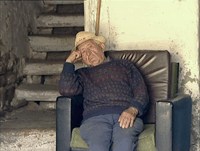Part elegy on the dying of a rural village, part exposition on mortality and obsolescence, and part exaltation of quotidian grace, Mercedes Álvarez’s El Cielo gira (The Turning Sky) is a serene, contemplative, and indelible rumination on the permanence of landscape, the transitory nature of existence, the imprint of history, and the eternal cycle of natural transformation. An introductory sequence juxtaposing the depopulation of Álvarez’s ancestral village in the bucolic, agrarian community of Aldealseñor in the province of Soria with metaphoric images of local artist, Pello Azketo at work on his latest painting in his studio, sets the crepuscular tone for the film, as Azketo, visibly suffering from the effects of a degenerative eye condition, stands within a few inches of the canvas in order to study the texture of his painted, turning sky – an intimate, observant gaze of a recreated memory that is, all too palpably, receding and ephemeral. This theme of captured imprint and transfiguration is reinforced in the establishing sequence of an elderly villager following the curious trail of thee-toed fossilized footprints on a series of rocks that lead to a sedimentary clearing once used as a playing field in her youth – the lateral outline of a small dinosaur frame creating a figurative prehistoric trail towards its inexorable death. A subsequent conversation between cemetery caretakers evolving from their experiences with unexpectedly unearthing ancestral bones while preparing a plot for burial, to suggesting a pragmatic idea to dig larger and deeper graves in order to adequately plan for the inevitable deaths of the aging villagers, evokes the preceding palimpsestic image of the fossil turned playground, and intrinsically connects the two seemingly disparate sequences into a unifying metaphor for silent extinction.
Nearby, a similar transfiguration of an eternal landscape is illustrated in the construction of a windmill farm along a hill and subsequently, in the large-scale renovation of an ancient Moor castle, long since abandoned (and whose last occupants’ departure is only vaguely remembered by the elders of Aldealseñor), into a luxury hotel. Meanwhile, an archaeologist conducts a tour of the neighboring ancient ruins of Numancia, the site of the final Roman siege in 133 B.C. where the Celtiberians, facing certain defeat, resolved to take their own lives in a Masada-like mass suicide rather than be enslaved by the Roman invaders. Juxtaposed against the eternal, yet ever transforming desolate landscape, the death of an ancient community is chronicled, not only within the scholarly discipline of contextualizing excavated artifacts in an academic study of the history of civilization, but also within the intimate orality of the villagers’ personal history and collective memory. Moreover, it is interesting to note that through an encounter between a pair of Moroccan natives – an immigrant shepherd and a professional athlete who has come to the rural area in order to focus on his marathon training – Álvarez not only underscores the impermanence of existence, but also subverts the (western) notion of territoriality and ownership of the land, as the long forgotten history of a Moor settlement on the region (as symbolized the derelict castle) is figuratively repeated in the re-emergence of the Moroccan settlers in the area, and implicitly alludes to the turned fortunes of the Roman invaders whose conquered lands were eventually occupied – then similarly relinquished – by the Moors in the recursive tide of history (an inconstancy that is also reflected in the humorous appearances of competing political parties – one bearing such inappropriate token gifts as balloons, candies, and condoms – in the tiny village to solicit votes). Returning to Azketo’s studio as the now nearly blind artist prepares the canvas for what would perhaps be his final work, a pastoral – and increasingly impressionistic – landscape contoured by the ephemeral haze of failing eyesight and inexact memory, the painting becomes, not only a temporally frozen image of a village on the brink of extinction, but also an encapsulation of the film itself – a reverent and privileged glimpse of an obsolete existence on the cusp of invisible transcendence.
© Acquarello 2007. All rights reserved.
